Proponents of laser sights say the electronic devices make it easier and faster to hit a target—on average, a half second to 1 second faster, depending on the shooter. Mainly, the reason is optical: Shooting with iron sights takes effort, since three focal planes need to be aligned: rear sight, front sight, and target. By projecting an aiming point onto the target plan, the laser folds all three sight plans into one target plane. Place the dot on a target at the zeroed in range, and that is where the bullets will hit. Another advantage laserphiles claim is that lasers allow the shooter to hit targets from unconventional or inconvenient shooting positions with ease. And, importantly, laser sights also make good training devices. Dry-firing exercises with the red dots show shooters if they are correctly pressing back on the trigger and not exerting side pressure, or have some other flaw that the jiggling red dot exposes.
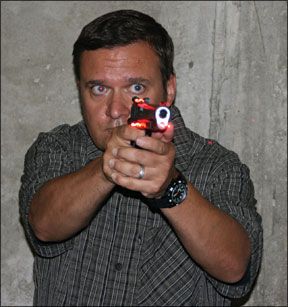
Light Amplification by Stimulated Emission of Radiation, or, laser for short, is a way to emit electromagnetic radiation in the form of visible light. Physics aside, a laser sight is actually a laser pointer on steroids. The FDA regulates laser sights as Class IIIa devices that operate at 1 to 5 mW (milliwatts). Early generations of laser sights were conspicuous bolt-ons. More gadget than gear. Current laser sights are more integrated with firearms. We wanted to test current laser sights to see how they would perform, including ease of installation and use, durability and concealability, so we chose the Crimson Trace LG-401, $329; LaserLyte’s RL-19N, $200; and the LaserMax LMS-1911M, $400, as three examples of lasers that operate slightly differently because of how they’re fitted to the gun.
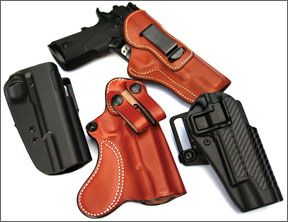
Several cautionary notes, however. Lasers can be hazardous. In fact, Crimson Trace instructs buyers to attach a tiny warning label on their firearms before the sight is installed, and it warns about shining lasers in your or other people’s eyes, as the rays may damage the recipients’ retinas. Also, it’s useful to note that a laser can reflect off hard, smooth surfaces. When you hear a bump in the night and activate a laser, be aware of your surroundings. Mirrors, glass, TV screens, and other surfaces will reflect a laser’s dot. The reflected light could temporarily disorient you or deflect, looking like multiple lasers. Save the light shows for the concert arenas. Have a plan in mind to illuminate your targets, but not the wife’s glass-fronted cabinets. Also, firearms with lasers require additional maintenance. Oil, dust, and other debris on the glass window of the laser’s projection port can diffuse the beam. Clean the glass window, and the laser’s dot will be sharp and clear. Crimson Trace recommends removing the grips prior to cleaning. Excessive oil can also affect circuitry. Replace the batteries, just as you would with a flashlight. If you use the laser sights often, replace them more frequently. And there’s the signature debate: the laser may be a deterrent or it may not. A bad guy can see the laser and back off knowing his position is compromised, or if he is determined to do harm, the laser indicates your location.
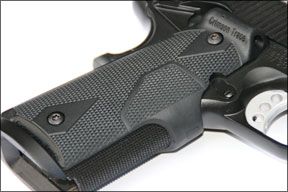
How We Tested
First, we determined ease of installation. A Springfield 1911 TRP has common features found on many 1911s—ambidextrous safety, mag well, beavertail grip safety—and served as our platform.
After installation, we dropped-tested from a height of 36 inches onto a piece of -inch plywood on a concrete floor. The unloaded Springfield was dropped on the left and right sides, top, bottom, muzzle and hammer ends. This test simulated a drop from hip height due to a clumsy holster draw or a fumble from a nightstand drawer.
We also froze the sights for 30 minutes to see if the buttons would work in a cold environment. We then sprayed the TRP and sights with water to test water resistance.
The lasers’ compatibility with a variety of concealed carry holsters was also tested to see if the laser could accidentally be turned on by holstering or unholstering or increase a tell-tale carry imprint. For leather holsters, these models were used: DeSantis’ Inner Piece with screw retention and Blackhawk Inside-The-Pants. Polymer holsters consisted of Blackhawk’s carbon fiber Serpa Concealment with a retention system that locks onto the trigger guard and is released via a built-in button, and a Blade-Tech Kydex SRB with screw retention.
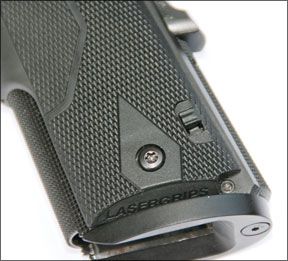
We then went to the range for live firing to look for ease in zeroing, ability to stay zeroed, and ease of use. Federal’s American Eagle brand ammo and Winchester’s white box 230-grain ball cartridge ammo were employed on IDPA-style targets at 10 yards. Firing consisted of two-handed aimed firing and one-handed point firing from hip level. Iron sights were not used, only the laser’s red dot. The goal was to fire five shots as fast as we could while hitting center of mass.
Here’s what we found:
Crimson Trace LG-401, $329
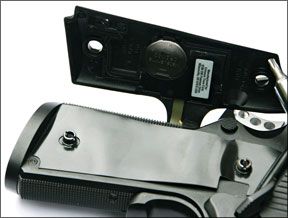
The Crimson Trace laser included a one-piece grip, two dust panels, two batteries, allen wrenches, cleaning swabs and instructions. The grips were attached by a small saddle piece that held the laser activation button. Crimson Trace calls it a pad. One battery snapped into the underside of each grip panel. A hex wrench was necessary to remove the TRP’s gritty grip panels prior to installing the dust panels, basically a thin piece of plastic that helped seal out debris and the elements. Then the Crimson Trace grip was secured using the original TRP grip screws. There was a gap between the TRP’s mag well and the bottom edge of the grip panels. If no mag well were present, the grip would have tapered off like original grips. A master switch was located in the lower right-hand corner of the left-side grip panel. This switch required effort to operate, as it was flush with the grip surface and needed to be on for the laser-sight activation pad to operate. We do not think this switch could accidentally be turned on. Pressing the pad turned the laser on; releasing the pad turned it off. It was located directly under the trigger guard and could be activated by the second joint of the middle finger or the finger tip of the shooter’s firing hand. It was easy to operate when we concentrated, which also forced us to rethink our grip. There was no way that the laser could constantly be turned on. The right grip panel housed the laser projection port and adjustment screws.
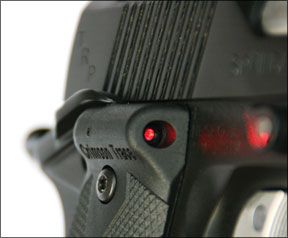
The Crimson Trace showed no effect from the drop test nor did the LaserMax. The Crimson Trace worked well with all holster types, but we did activate the laser upon drawing and undrawing from the holster. With the kill switch turned off, this was a non-issue. The freezer had no impact on the operation of the activation buttons for any of the lasers, though cold temperatures will shorten battery life. The water-spray test did not cause any of the lasers to fail, but water on the laser glass lens did distort the laser dot. Wiping it dry was required to have the dot to show sharply on target.
At the range, the Crimson Trace’s dot showed up better in bright light compared to the others, our testers said. It also was slightly larger than the the LaserLyte and LaserMax dots. It was the only sight that did not need to be sighted in. It was good to go from the box, but we adjusted the windage and elevation anyway off zero, then quickly brought the sight back to zero. The TRP loved the Federal ammo, and a five-shot group would have had all holes touching if it were not for a hot empty the landed in the crook of the shooter’s arm. We wouldn’t necessarily mention this group but we shot it from the hip by placing the laser’s red dot on the target. We never even looked at the 1911 when firing. The heavy Federals and Winchester loads did not affect point of aim on any of the lasers after extended shooting sessions.
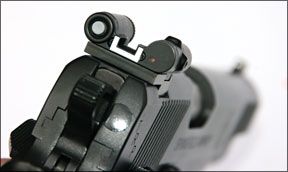
Our Team Said: The Crimson Trace was easy to install and use. Testers had to rethink their grip. The middle finger now had a new job: activate the laser. Some of the TRP’s excellent 20-lpi checkering on the grip strap was lost due to the activation button. They liked the fact that the on/off button just needed to be released to turn off the sight. Testers also liked the fact it could be operated with just the shooting hand. Downside: Those wanting to flaunt barbecue grips or use other types cannot.
LaserLyte RL-19N, $200
Included in the clear plastic blister pack were an extra four batteries, a brass dowel, and easy-to-understand instructions. It also had the ultrathin allen wrenches like the Crimson Trace and LaserMax. Batteries were preinstalled. To install the LaserLyte, the TRP’s rear sight was drifted out of its dovetail with the supplied brass dowel and a hammer. Then the LaserLyte was slid into the dovetail and secured with a set screw. The sight had an iron rear sight with white outline built in. From the rear, the unit looked like two pontoons above a rear iron sight. The pontoon on the left held the batteries and the on/off switch; the right one held the laser and windage and elevation screws and LED activation light. It had two modes of operation: pulsating and steady. Press the on/off button once and the steady or constant mode is activated. Press the button a second time and the pulsating mode is activated. Press it a third time to turn it off. A small LED indicator light mimics the mode you are in. The easiest way to turn on the laser was to use the thumb of supporting hand. Shooters with long thumbs could possibly activate the sight with the thumb of the shooting hand but by doing this you loosen your grip on the pistol and defeat the purpose of the beavertail grip safety. In either situation a thumb may be behind the slide. It is vital that the trigger finger and thumbs work in unison or a thumb could get whacked with the slide.
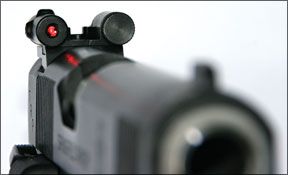
During the drop test the LaserLyte was knocked out of zero. We thought this may have been our fault for not tightening the set screw. We re-aligned and tightened the set screw with no other mishaps.
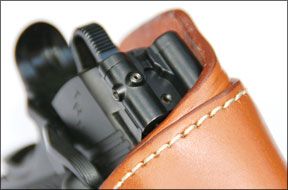
The LaserLyte has a slightly larger imprint than the Novak sight it replaced but is did not print in our concealment test using a BlackHawk 1700 shirt, which is lightweight and as casual as you can get without having a Hawaiian print. The LaserLyte did not allow the TRP to fully holstered in the Blackhawk Inside-The-Pants holster. It worked fine in all the other holsters. The activation button was exposed when holstered and could be activated accidentally.
The dot was hard to see in bright sunlight and many times we had to stop and find it. We saw no clear advantage or disadvantage over the pulsating and steady modes. The LaserLyte pulsed slower than the LaserMax, but both flashed so quickly there was no moment when the lasers seemed turned off. Adjustments were easy to make, but we ran out of play in the windage screw and needed to loosen the entire sight and drift it over to finally align it.

0)]
Our Team Said: Testers agreed that more training was needed to activate the LaserLyte in a way that a thumb or finger avoided the backward movement of the slide during shooting. The LED indicator light seemed redundant and some thought it could be confused with the dot under duress. They liked the fact the batteries were everyday watch batteries and thought the price was reasonable compared to the others.
LaserMax LMS-1911M, $400
If you can disassemble a 1911 for basic cleaning, then the LaserMax will be the easiest to install. Remove the slide, pop out the guide rod and replace it with the LaserMax rod. Instead of using the stock slide-lock lever, LaserMax provides a replacement that acts like a traditional slide stop as well as the switch to activate the laser. Reinsert the LaserMax slide stop and attach on the right side a small teardrop-shaped switch and lock it in place with the provided allen wrench. LaserMax also provides a plastic bushing wrench in case it is needed as well as clear instructions.
The switch can be operated from both sides of the pistol. Pointing straight back turns the laser off; rotating it down turns it on. The switch can easily be rotated by the thumb of the supporting hand. The switch was difficult to use at first but soon loosened so it was easier to operate but not likely to turn on by accident.

1)]
The sight could be adjusted by unloading the pistol and locking back the slide. Looking directly at the muzzle, there were two adjustment screws on the guide rod. The left screw adjusted for windage, the bottom screw adjusted elevation.
The sight was not activated by the holsters we tested. There was also no way the LaserMax could be accidentally turned on while holstered.
One tester accidentally turned on the laser during recoil by a poor supporting grip. That was the only incident. The LaserMax was not as bright as the Crimson Trace but had a natural pointing ability. Shooters liked the LaserMax second to the Crimson Trace for the fact it needed two hands to be operated, though some shooters were able to activate the laser with their trigger finger without compromising their grip.
Our Team Said: The LaserMax was the most integrated of all the sights and allowed shooters to keep original and aftermarket grips. It also did not cause the shooter to change his shooting-hand grip, which they liked. The support hand, however, had the new job of activating the laser for most shooters.


























Is Laser Max grip sense any good?